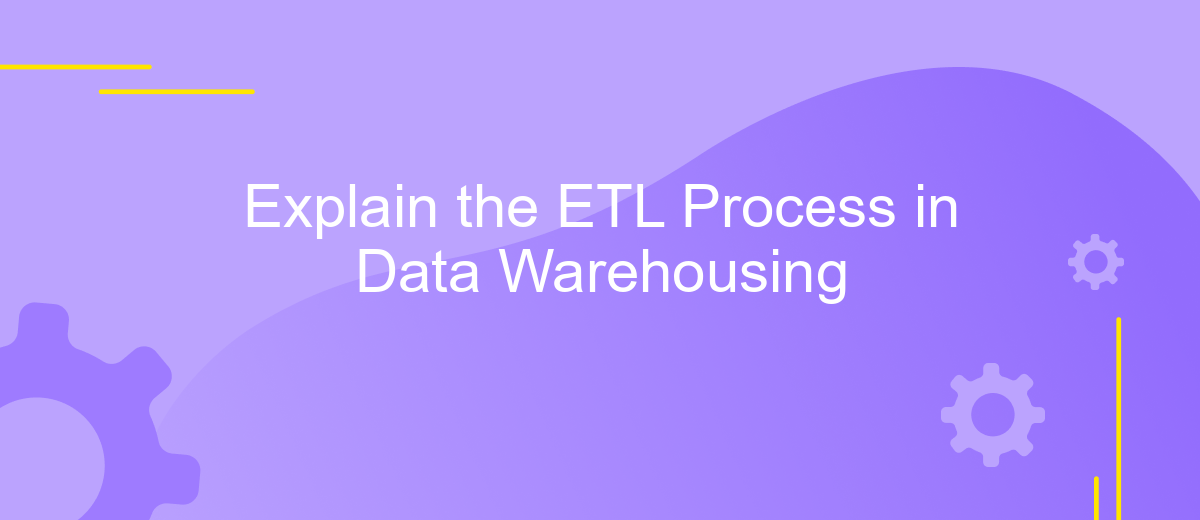Explain the ETL Process in Data Warehousing
The ETL process, which stands for Extract, Transform, Load, is a fundamental component in data warehousing. It involves extracting data from various sources, transforming it into a suitable format, and loading it into a data warehouse. This process ensures that data is accurate, consistent, and ready for analysis, playing a crucial role in effective decision-making and business intelligence.
Introduction
The ETL process, which stands for Extract, Transform, Load, is a fundamental concept in the realm of data warehousing. This process is essential for integrating data from various sources into a centralized repository, enabling organizations to make data-driven decisions. By efficiently managing data extraction, transformation, and loading, businesses can ensure data accuracy, consistency, and availability.
- Extract: Data is collected from multiple sources, such as databases, APIs, and flat files.
- Transform: The extracted data is cleaned, formatted, and transformed to meet the requirements of the target data warehouse.
- Load: The transformed data is loaded into the data warehouse, making it available for analysis and reporting.
Many tools and services facilitate the ETL process, with ApiX-Drive being a notable example. ApiX-Drive simplifies the integration of various data sources, automating the extraction and loading phases while providing robust transformation capabilities. This ensures that businesses can maintain seamless and efficient data workflows, ultimately enhancing their data warehousing efforts.
Extraction

Extraction is the first crucial step in the ETL process, where data is collected from various source systems. These sources can include databases, cloud storage, APIs, and flat files, among others. The aim is to gather data in its raw form without any modifications. This step is essential for ensuring that the subsequent processes of transformation and loading have accurate and comprehensive data to work with.
To streamline the extraction process, tools like ApiX-Drive can be highly beneficial. ApiX-Drive simplifies the integration of multiple data sources by offering a user-friendly interface and robust API connections. This service allows organizations to automate the extraction of data, reducing manual effort and minimizing the risk of errors. By leveraging such tools, businesses can ensure that their data extraction processes are efficient, reliable, and scalable, setting a strong foundation for the entire ETL pipeline.
Transformation

Transformation is a crucial step in the ETL (Extract, Transform, Load) process, where raw data is converted into a format suitable for analysis. This phase involves various operations to clean, standardize, and enrich the data to ensure its quality and consistency.
- Data Cleaning: Removing duplicates, correcting errors, and handling missing values to ensure data accuracy.
- Data Standardization: Converting data into a common format or structure to enable seamless integration and comparison.
- Data Enrichment: Enhancing data quality by integrating additional information from external sources.
- Data Aggregation: Summarizing detailed data to provide a higher-level view for analysis.
Using tools like ApiX-Drive can simplify the transformation process by automating data integration and transformation tasks. ApiX-Drive allows you to set up custom workflows, ensuring that data from various sources is consistently transformed and ready for analysis. By leveraging such services, organizations can save time and reduce the risk of errors, ultimately improving the overall efficiency of their data warehousing processes.
Loading

The final phase in the ETL process is Loading, where the transformed data is loaded into the target data warehouse. This step is crucial as it ensures that the data is in a format suitable for analysis, reporting, and data mining.
Loading can be performed in various ways, depending on the requirements and architecture of the data warehouse. It can be done in bulk during off-peak hours or in real-time to ensure that the data warehouse is always up-to-date.
- Full Load: Loading all data from the source to the target data warehouse.
- Incremental Load: Loading only the new or updated data since the last load.
- Batch Load: Loading data in batches at scheduled intervals.
- Real-Time Load: Continuously loading data as it becomes available.
Services like ApiX-Drive can simplify the loading process by automating data integrations between various sources and the data warehouse. This ensures seamless data flow and reduces the need for manual intervention, thereby increasing efficiency and accuracy.
- Automate the work of an online store or landing
- Empower through integration
- Don't spend money on programmers and integrators
- Save time by automating routine tasks
Validation
Validation is a critical phase in the ETL process that ensures the accuracy and quality of the data before it is loaded into the data warehouse. This step involves a series of checks and balances designed to detect and correct errors, inconsistencies, and anomalies in the data. Validation can include verifying data formats, checking for missing values, confirming data types, and ensuring referential integrity. By performing these checks, organizations can maintain high data quality, which is essential for reliable business intelligence and analytics.
To streamline the validation process, organizations often leverage automated tools and services. One such service is ApiX-Drive, which facilitates seamless integration and data validation across various platforms. ApiX-Drive provides robust features for setting up validation rules, automating data checks, and generating detailed reports. This not only saves time but also reduces the risk of human error, ensuring that the data is both accurate and reliable. By incorporating tools like ApiX-Drive, businesses can enhance their ETL processes, leading to more efficient and trustworthy data warehousing.
FAQ
What is the ETL process in data warehousing?
Why is the ETL process important in data warehousing?
What are the main stages of the ETL process?
How often should the ETL process be run?
Can the ETL process be automated?
Routine tasks take a lot of time from employees? Do they burn out, do not have enough working day for the main duties and important things? Do you understand that the only way out of this situation in modern realities is automation? Try Apix-Drive for free and make sure that the online connector in 5 minutes of setting up integration will remove a significant part of the routine from your life and free up time for you and your employees.


